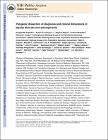| dc.contributor.author | CORVIN, AIDEN | en |
| dc.date.accessioned | 2015-12-15T17:03:07Z | |
| dc.date.available | 2015-12-15T17:03:07Z | |
| dc.date.issued | 2014 | en |
| dc.date.submitted | 2014 | en |
| dc.identifier.citation | Ruderfer DM, Fanous AH, Ripke S, McQuillin A, Amdur RL, Gejman PV, O'Donovan MC, Andreassen OA, Djurovic S, Hultman CM, Kelsoe JR, Jamain S, Landén M, Leboyer M, Nimgaonkar V, Nurnberger J, Smoller JW, Craddock N, Corvin A, Sullivan PF, Holmans P, Sklar P, Kendler KS, Polygenic dissection of diagnosis and clinical dimensions of bipolar disorder and schizophrenia., Molecular psychiatry, 19, 9, 2014, 1017-24 | en |
| dc.identifier.issn | 1359-4184 | en |
| dc.identifier.other | Y | en |
| dc.identifier.uri | http://hdl.handle.net/2262/75335 | |
| dc.description | PUBLISHED | en |
| dc.description.abstract | Bipolar disorder and schizophrenia are two often severe disorders with high heritabilities. Recent studies have demonstrated a large overlap of genetic risk loci between these disorders but diagnostic and molecular distinctions still remain. Here, we perform a combined genome-wide association study (GWAS) of 19 779 bipolar disorder (BP) and schizophrenia (SCZ) cases versus 19 423 controls, in addition to a direct comparison GWAS of 7129 SCZ cases versus 9252 BP cases. In our case-control analysis, we identify five previously identified regions reaching genome-wide significance (CACNA1C, IFI44L, MHC, TRANK1 and MAD1L1) and a novel locus near PIK3C2A. We create a polygenic risk score that is significantly different between BP and SCZ and show a significant correlation between a BP polygenic risk score and the clinical dimension of mania in SCZ patients. Our results indicate that first, combining diseases with similar genetic risk profiles improves power to detect shared risk loci and second, that future direct comparisons of BP and SCZ are likely to identify loci with significant differential effects. Identifying these loci should aid in the fundamental understanding of how these diseases differ biologically. These findings also indicate that combining clinical symptom dimensions and polygenic signatures could provide additional information that may someday be used clinically. | en |
| dc.format.extent | 1017-24 | en |
| dc.relation.ispartofseries | Molecular psychiatry | en |
| dc.relation.ispartofseries | 19 | en |
| dc.relation.ispartofseries | 9 | en |
| dc.rights | Y | en |
| dc.subject | Bipolar disorder | en |
| dc.title | Polygenic dissection of diagnosis and clinical dimensions of bipolar disorder and schizophrenia. | en |
| dc.type | Journal Article | en |
| dc.type.supercollection | scholarly_publications | en |
| dc.type.supercollection | refereed_publications | en |
| dc.identifier.peoplefinderurl | http://people.tcd.ie/acorvin | en |
| dc.identifier.rssinternalid | 109097 | en |
| dc.identifier.doi | http://dx.doi.org/10.1038/mp.2013.138 | en |
| dc.rights.ecaccessrights | openAccess | |
| dc.identifier.orcid_id | 0000-0001-6717-4089 | en |




